ESP Hyundai Matrix 2005 User Guide
[x] Cancel search | Manufacturer: HYUNDAI, Model Year: 2005, Model line: Matrix, Model: Hyundai Matrix 2005Pages: 407, PDF Size: 10.31 MB
Page 87 of 407

DRIVING YOUR HYUNDAI 2- 15
YC200E2-E
Trailer or Vehicle Towing Tips
1. Before towing, check towbar ball and safe- ty cable connections as well as proper operation of the trailer running lights, brake lights, and turn signals.
2. Always drive your vehicle at a moderate speed (Less than 60 MPH)
3. Trailer towing requires more fuel than nor- mal conditions.
4. To maintain engine braking efficiency and electrical charging performance, do not usefifth gear (manual transaxle) or overdrive (automatic transaxle). 5. Always secure items in the trailer to pre-
vent load shift whilst driving.
6. Check the condition and air pressure of all tyres on the trailer and your car. Low tyrepressure can seriously affect the handling. Also check the spare tyre.
7. The vehicle/trailer combination is more af- fected by crosswind and buffeting. When being passed by a large vehicle,keep a constant speed and steer straight ahead. If there is too much wind buffeting slow down to get out of the other vehicle's air turbulence.
8. When parking your car and trailer, espe- cially on a hill, be sure to follow all thenormal precautions. Turn your front wheels into the curb, set the parking brake firmly, and put the transaxle in 1st or Reverse (manual) or Park (automatic). In addition, place wheel chocks at each of the trailer's tyres.
9. If the trailer has electric brakes, start your vehicle and trailer moving, and then applythe trailer brake controller by hand to be sure the brakes are working. This lets you check your electrical connection at the same time.
10.During your trip, check occasionally to be sure that the load is secure, and that thelights and any trailer brakes are still work- ing. 11.Avoid jerky starts, sudden acceleration or
sudden stops.
12.Avoid sharp turns and rapid lane changes.
13.Avoid holding the brake pedal down too long or too frequently. This could causethe brakes to overheat, resulting in re- duced braking efficiency.
14.When going down a hill, shift into a lower gear and use the engine braking effect. When ascending a long grade, downshiftthe transaxle to a lower gear and reduce speed to reduce chances of engine over- loading and/or overheating.
15.If you have to stop whilst going uphill, do not hold the vehicle in place by pressing onthe accelerator. This can cause the auto- matic transaxle to overheat. Use the park- ing brake or footbrake.
NOTE:When towing check transaxle fluid more
frequently.
CAUTION:If overheating should occur when towing,
(temperature gauge reads near red zone), taking the following action may reduce or eliminate the problem.
1. Turn off the air conditioner.
2. Reduce highway speed.
3. Select a lower gear when going uphill.
4. While in stop and go traffic, place the gear selection in park or neutral andidle the engine at a higher speed.
Towing BracketAttachment Location
o The maximum permissible static verti-
cal load on the coupling device : 52kg
o The maximum permissible overhang of the coupling point : 760 mm.
C190E01FC
Page 100 of 407
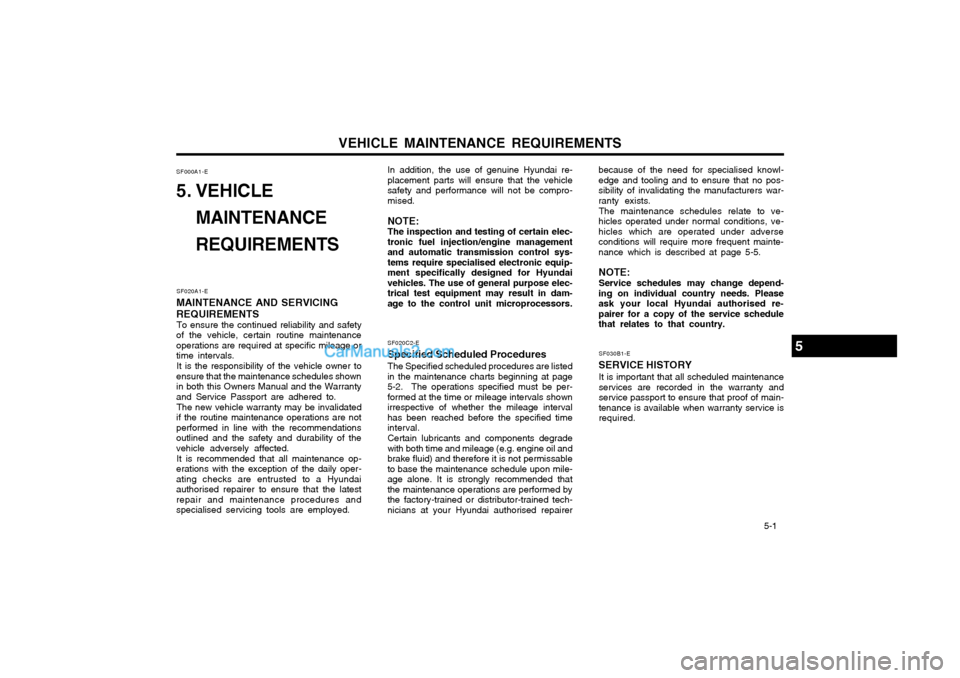
VEHICLE MAINTENANCE REQUIREMENTS 5-1
SF020A1-E
MAINTENANCE AND SERVICING REQUIREMENTS To ensure the continued reliability and safety
of the vehicle, certain routine maintenance operations are required at specific mileage ortime intervals.
It is the responsibility of the vehicle owner to
ensure that the maintenance schedules shownin both this Owners Manual and the Warrantyand Service Passport are adhered to.
The new vehicle warranty may be invalidated
if the routine maintenance operations are notperformed in line with the recommendationsoutlined and the safety and durability of thevehicle adversely affected.
It is recommended that all maintenance op-
erations with the exception of the daily oper-ating checks are entrusted to a Hyundaiauthorised repairer to ensure that the latestrepair and maintenance procedures andspecialised servicing tools are employed. In addition, the use of genuine Hyundai re-
placement parts will ensure that the vehiclesafety and performance will not be compro-mised. NOTE: The inspection and testing of certain elec-
tronic fuel injection/engine management and automatic transmission control sys-tems require specialised electronic equip-ment specifically designed for Hyundaivehicles. The use of general purpose elec-trical test equipment may result in dam-age to the control unit microprocessors.
SF000A1-E
5. VEHICLE
MAINTENANCE REQUIREMENTS
SF020C2-E
Specified Scheduled Procedures The Specified scheduled procedures are listed
in the maintenance charts beginning at page 5-2. The operations specified must be per-formed at the time or mileage intervals shownirrespective of whether the mileage intervalhas been reached before the specified timeinterval.
Certain lubricants and components degrade
with both time and mileage (e.g. engine oil andbrake fluid) and therefore it is not permissableto base the maintenance schedule upon mile-age alone. It is strongly recommended thatthe maintenance operations are performed bythe factory-trained or distributor-trained tech-nicians at your Hyundai authorised repairer because of the need for specialised knowl-edge and tooling and to ensure that no pos-sibility of invalidating the manufacturers war-ranty exists.
The maintenance schedules relate to ve-
hicles operated under normal conditions, ve-hicles which are operated under adverseconditions will require more frequent mainte-nance which is described at page 5-5. NOTE:
Service schedules may change depend-
ing on individual country needs. Please ask your local Hyundai authorised re-pairer for a copy of the service schedulethat relates to that country.
SF030B1-E
SERVICE HISTORY It is important that all scheduled maintenanceservices are recorded in the warranty andservice passport to ensure that proof of main-tenance is available when warranty service isrequired.
5
Page 112 of 407

OWNER MAINTENANCE 6-5
SG030C2-E Engine Oil Level
G030B03FC-EAT
2.Diesel Engine The correct engine oil level is of paramount importance. An excessively high or low oillevel may result in irreparable damage beingsustained by the engine. The engine oil levelmust be checked on a daily basis, wheneverthe vehicle is refuelled or before starting along trip, whichever occurs sooner.
G030B02B
The engine oil level should be checked with
the engine at normal operating temperature and the vehicle parked upon level ground. Prior to checking the level, the vehicle should
be allowed to stand for several minutes after theengine has been switched off to allow the oil todrain back to the sump.
HFC5007
G030C02FC
Petrol engine
Diesel engine
NOTE: SAE 5W-20 (5W-30), ILSAC GF-3 engine
oil is preferred regardless of regional option and engine variation. If SAE 5W-20,ILSAC GF-3 engine oil is not available,secondary recommended engine oil forcorresponding temperature range can beused. In addition, it is imperative that only an ap-
proved grade and specification of oil is usedto avoid the possibility of serious engine dam-age and premature wear. The use of "budgetprice" oil is a false economy that must beavoided if the maximum reliability and usefullife is to be obtained from the vehicle.
The engine oil quality should meet the follow-
ing classification:
API class: CH-4 or ABOVEACEA class: B4 or ABOVE NOTE: SAE 0W-30 oil is for use in very cold
zones. Its use should therefore be re- stricted only to driving in these type ofsub-zero conditions. (Especially, not rec-ommended for sustained high engine loadand high speed operation.)
Page 117 of 407
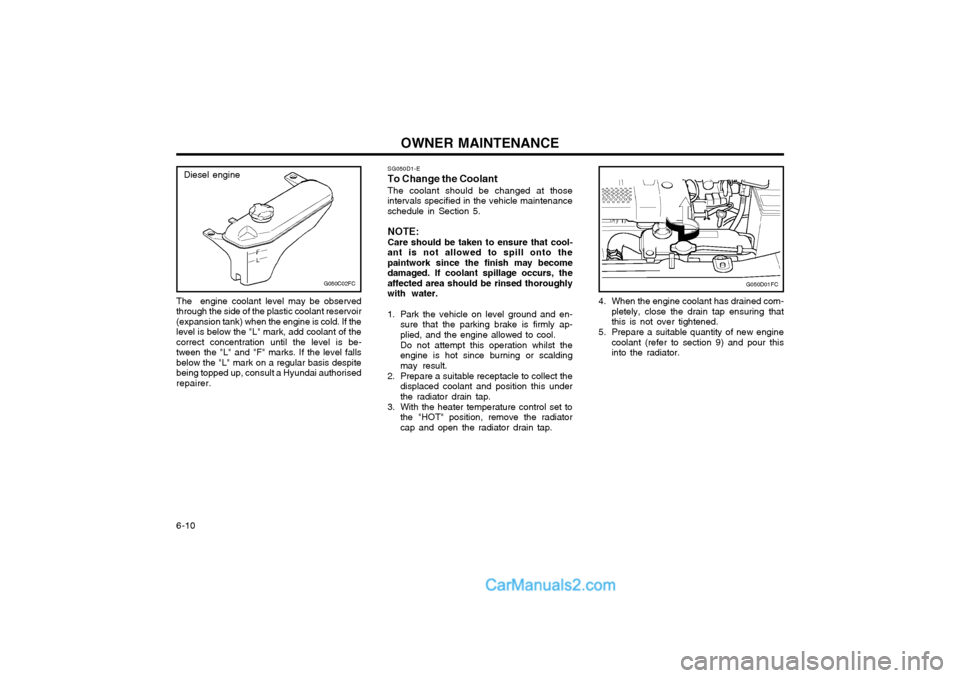
OWNER MAINTENANCE
6-10 SG050D1-E
To Change the Coolant
The coolant should be changed at those
intervals specified in the vehicle maintenance schedule in Section 5.
NOTE: Care should be taken to ensure that cool-
ant is not allowed to spill onto the paintwork since the finish may becomedamaged. If coolant spillage occurs, theaffected area should be rinsed thoroughlywith water.
1. Park the vehicle on level ground and en- sure that the parking brake is firmly ap- plied, and the engine allowed to cool. Do not attempt this operation whilst the engine is hot since burning or scaldingmay result.
2. Prepare a suitable receptacle to collect the displaced coolant and position this underthe radiator drain tap.
3. With the heater temperature control set to the "HOT" position, remove the radiatorcap and open the radiator drain tap. 4. When the engine coolant has drained com-
pletely, close the drain tap ensuring thatthis is not over tightened.
5. Prepare a suitable quantity of new engine coolant (refer to section 9) and pour thisinto the radiator.
G050D01FC
The engine coolant level may be observed through the side of the plastic coolant reservoir(expansion tank) when the engine is cold. If thelevel is below the "L" mark, add coolant of thecorrect concentration until the level is be-tween the "L" and "F" marks. If the level fallsbelow the "L" mark on a regular basis despitebeing topped up, consult a Hyundai authorisedrepairer.
G050C02FC
Diesel engine
Page 141 of 407

CONSUMER INFORMATION 8-1
SI010B1-E
Engine Number
SI000A1-E
8. CONSUMER
INFORMATION
I010A01FC-EAT
VEHICLE IDENTIFICATION
NUMBER (VIN) The vehicle identification number (VIN) is
unique to each individual vehicle and is the number (sometimes referred to as chassisnumber) used upon the vehicle registrationdocument to identify the vehicle.
It can be found on the identification plate
attached to apron panel located on the driver'sside of the engine compartment. The engine number is stamped on the engine
block as shown in the drawing. I030A01FC-EAT
TYRE PRESSURES
In modern high-speed motoring, correct tyre
pressures are vitally important. Incorrect tyrepressures can affect vehicle safety by caus-ing reduced adhesion, steering response andtyre failure through overheating. The tyrepressure must only be checked when thetyres are cold. The correct tyre pressuresare indicated on the label affixed to the driver'sside "C" piller outer panel and below.
Diesel engine
I010B02B8
HFC6001
EADA010C
Petrol engine
5.5Jx14 5.5Jx15 6.0Jx15 3.5Jx153.5Jx15
TYRE
SIZE
RIM
SIZE PRESSURE, kPa (PSI)
185/65R14195/55R15 205/55R15
T115/70D15 T115/70R15 REAR
210(30)210(30)210(30)420(60)420(60) FRONT
250(36)250(36) 250(36) 420(60)420(60)
UP TO 2
PERSONS UP TO
MAX. LOAD
REAR
250(36)250(36) 250(36) 420(60)420(60)
FRONT210(30)210(30)210(30) 420(60) 420(60)
I030A01FC-D
Page 153 of 407
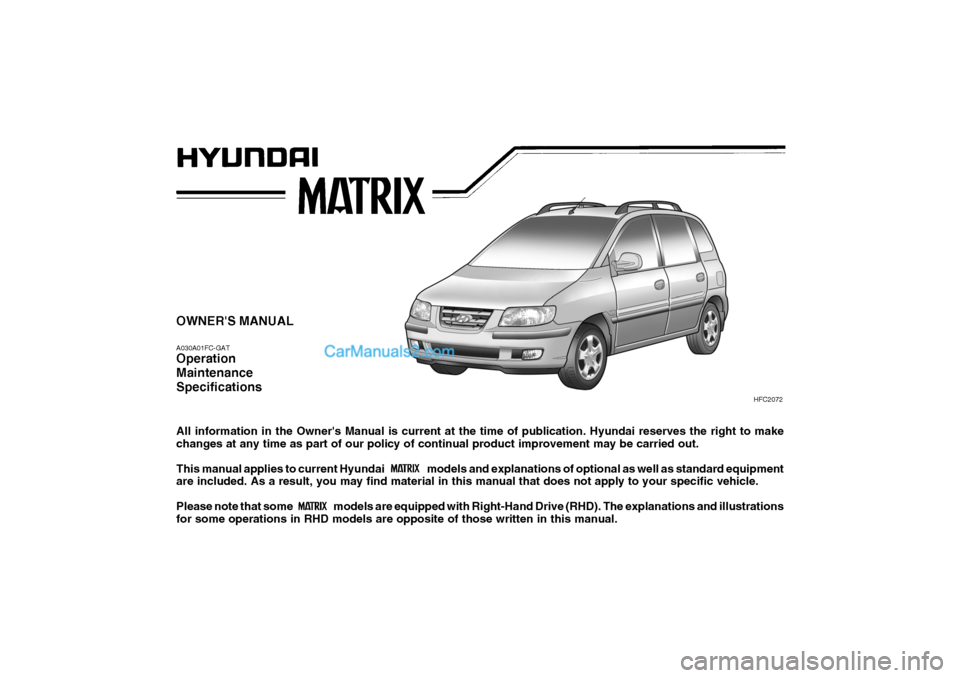
OWNER'S MANUAL A030A01FC-GAT Operation MaintenanceSpecifications All information in the Owner's Manual is current at the time of publication. Hyundai reserves the right to make changes at any time as part of our policy of continual product improvement may be carried out. This manual applies to current Hyundai models and explanations of optional as well as standard equipment are included. As a result, you may find material in this manual that does not apply to your specific vehicle. Please note that some models are equipped with Right-Hand Drive (RHD). The explanations and illustrations for some operations in RHD models are opposite of those written in this manual.
HFC2072
Page 154 of 407
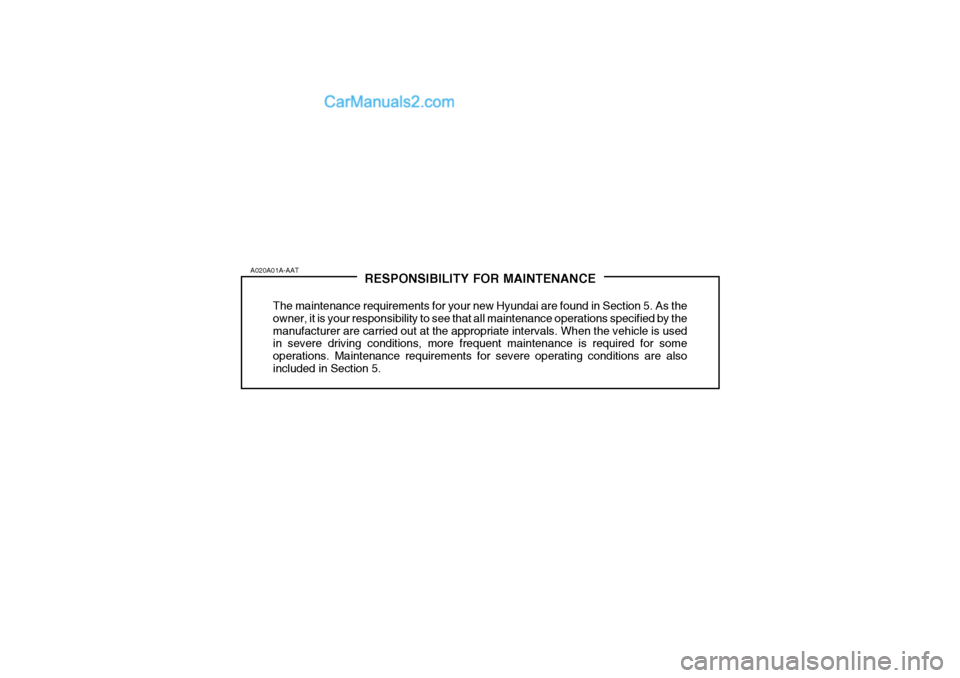
RESPONSIBILITY FOR MAINTENANCE
The maintenance requirements for your new Hyundai are found in Section 5. As the owner, it is your responsibility to see that all maintenance operations specified by themanufacturer are carried out at the appropriate intervals. When the vehicle is used in severe driving conditions, more frequent maintenance is required for some operations. Maintenance requirements for severe operating conditions are also included in Section 5.
A020A01A-AAT
Page 196 of 407
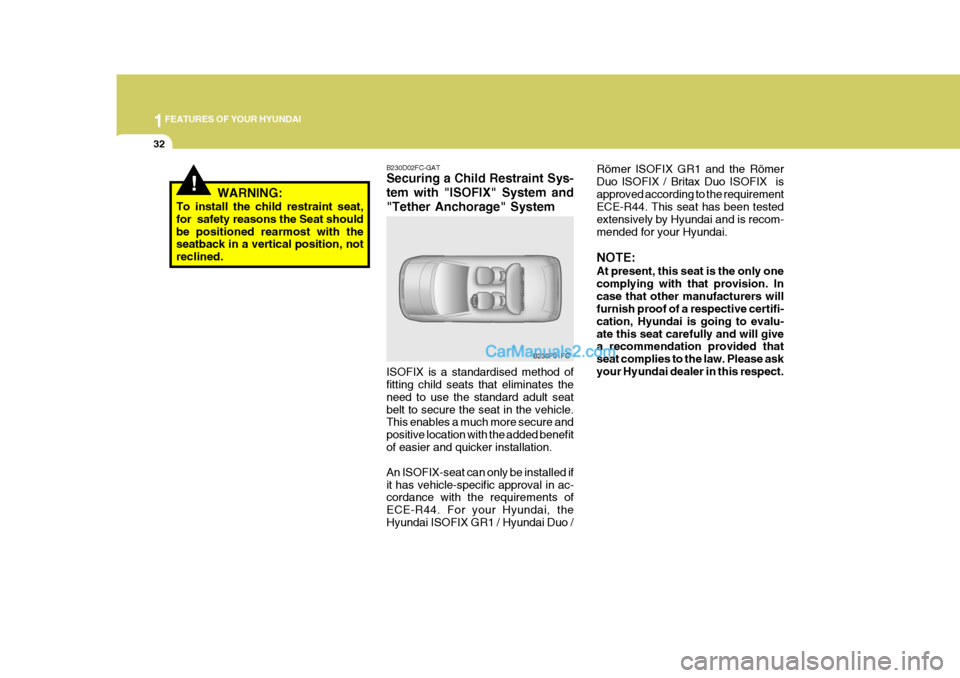
1FEATURES OF YOUR HYUNDAI
32
Römer ISOFIX GR1 and the Römer Duo ISOFIX / Britax Duo ISOFIX isapproved according to the requirement ECE-R44. This seat has been tested extensively by Hyundai and is recom-mended for your Hyundai. NOTE: At present, this seat is the only one complying with that provision. Incase that other manufacturers will furnish proof of a respective certifi- cation, Hyundai is going to evalu-ate this seat carefully and will give a recommendation provided that seat complies to the law. Please askyour Hyundai dealer in this respect.
!
B230D02FC-GAT Securing a Child Restraint Sys- tem with "ISOFIX" System and"Tether Anchorage" System ISOFIX is a standardised method of fitting child seats that eliminates the need to use the standard adult seatbelt to secure the seat in the vehicle. This enables a much more secure and positive location with the added benefitof easier and quicker installation. An ISOFIX-seat can only be installed if it has vehicle-specific approval in ac- cordance with the requirements of ECE-R44. For your Hyundai, theHyundai ISOFIX GR1 / Hyundai Duo / B230F01FC
WARNING:
To install the child restraint seat,for safety reasons the Seat shouldbe positioned rearmost with the seatback in a vertical position, not reclined.
Page 220 of 407
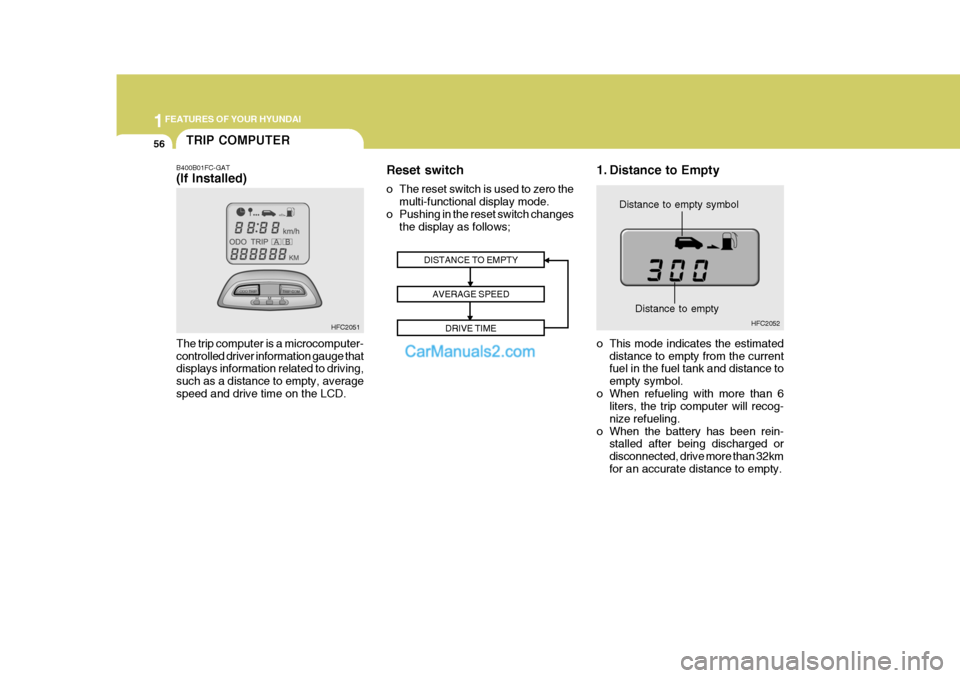
1FEATURES OF YOUR HYUNDAI
56TRIP COMPUTER
B400B01FC-GAT (If Installed) The trip computer is a microcomputer- controlled driver information gauge that displays information related to driving, such as a distance to empty, averagespeed and drive time on the LCD. 1. Distance to Empty
Distance to empty symbol
DISTANCE TO EMPTY AVERAGE SPEED DRIVE TIME
HFC2051 HFC2052
Distance to empty
o This mode indicates the estimated distance to empty from the current fuel in the fuel tank and distance to empty symbol.
o When refueling with more than 6 liters, the trip computer will recog-nize refueling.
o When the battery has been rein- stalled after being discharged ordisconnected, drive more than 32kmfor an accurate distance to empty.
Reset switch
o The reset switch is used to zero the
multi-functional display mode.
o Pushing in the reset switch changes the display as follows;
Page 221 of 407
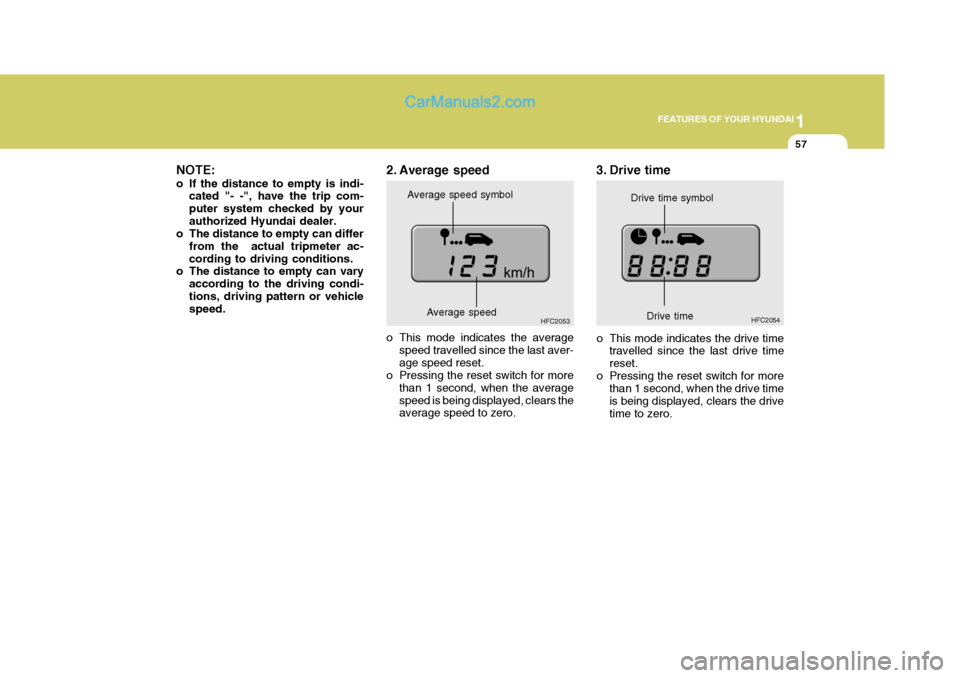
1
FEATURES OF YOUR HYUNDAI
57
HFC2054
2. Average speed
o This mode indicates the average
speed travelled since the last aver- age speed reset.
o Pressing the reset switch for more
than 1 second, when the averagespeed is being displayed, clears the average speed to zero.Average speed symbol
HFC20533. Drive time
o This mode indicates the drive time travelled since the last drive time reset.
o Pressing the reset switch for more than 1 second, when the drive timeis being displayed, clears the drivetime to zero. Drive time symbol
Average speed Drive time
NOTE:
o If the distance to empty is indi-
cated "- -", have the trip com- puter system checked by yourauthorized Hyundai dealer.
o The distance to empty can differ
from the actual tripmeter ac-cording to driving conditions.
o The distance to empty can vary
according to the driving condi-tions, driving pattern or vehicle speed.